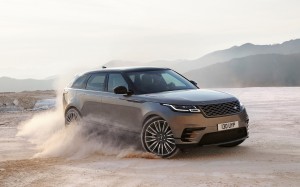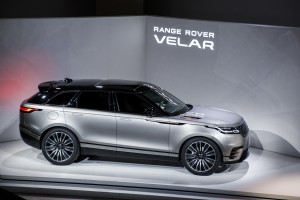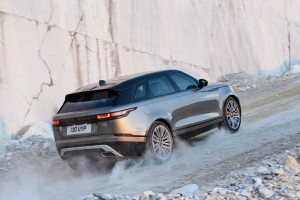The new Range Rover Velar made an early debut in London on Wednesday, ahead of next week’s Geneva Motor Show. The fourth member of Land Rover’s upscale family, it is meant to slot between the “base” Evoque model and the Range Rover Sport.
While there had been some speculation the British maker would deliver a toned-down “soft-roader,” the new Range Rover Velar maintains the off-road creds the brand has long been known far, while adding a number of new technologies including a semi-autonomous trailer “Tow Assist” function.
“The new Range Rover Velar brings a new dimension of modernity to our brand while reinforcing our total commitment to design and engineering excellence,” declared Land Rover Chief Design Officer Gerry McGovern, during the debut of the new ute at the Design Museum of London.
Visually, the new Velar picks up some of its design cues from the Evoque, with a sloping roof line. The roof itself is three-quarters glass, using the latest Panoramic sunroof technology. From the sides, a rising belt line counters the sloping roof, accentuating a fastback-like silhouette.
(Land Rover Velar to add coupe-like model to Range Rover line. Click Here for the story.)

Not a "soft-roader," the new Velar sports a coupe-like look but has the heart of Range Rovers past for off-road credibility.
At 113.15 inches, the wheelbase of the Range Rover Velar is notably longer than the Evoque, allowing for significantly more interior space – especially in the rear seat, resolving one of the complaints about the entry model in the Range Rover line-up. There is a full 34 cubic feet of storage available behind the second row of seats.
Cats-eye LED headlamps give a more aggressive look to the nose of the new Velar, while flush door handles further accentuate an overall, taut appearance. At 0.32, the new model offers the sort of aerodynamics normally expected of a sedan or coupe, rather than an SUV.
The Velar will be offered with an assortment of alloy wheel designs, including large 22-inchers.
Land Rover claims the new ute will be the highest-tech offering it has so far introduced. Inside, for example, the new Touch Pro Duo system relies on twin 10-inch high-definition touchscreens to operate the Velar’s infotainment package.
(Mercedes goes to extremes with Maybach G650 Landaulet. Click Here for the story.)
Like other Range Rover models, Velar features a Terrain Response system that allows the driver to easily dial in a variety of vehicle settings – including throttle response, gearing and ride height – using a single knob to adapt to conditions ranging from snow and ice to sand or dry pavement.
The aluminum-bodied Velar boasts a towing capacity of up to 5,500 lbs when equipped with a six-cylinder engine.
Meanwhile, one of the more intriguing options is what Land Rover calls the Advanced Tow Assist function. “Instead of directly steering the vehicle when backing up,” the maker explains, “the driver can aim where they want the trailer to go using the Touch Pro Duo rotary controller, and the vehicle determines what steering inputs are needed to direct the trailer where required.”
A wide range of diesel and gasoline powertrains will be offered for the Velar. In the U.S., there will be three powertrains: a 180-horsepower Ingenium 4-cylinder turbodiesel, a 247-hp 2.0-leader gas version of the Ingenium, and a 380-hp supercharged V-6. All of the engines will be paired to an eight-speed ZF automatic.
(Luxury SUVs outselling sedans for first time ever. Click Here for the story.)
The 2018 Range Rover Velar will go on sale in the U.S. “later this year,” according to Land Rover, with a starting price of $49,900 plus delivery fees.


